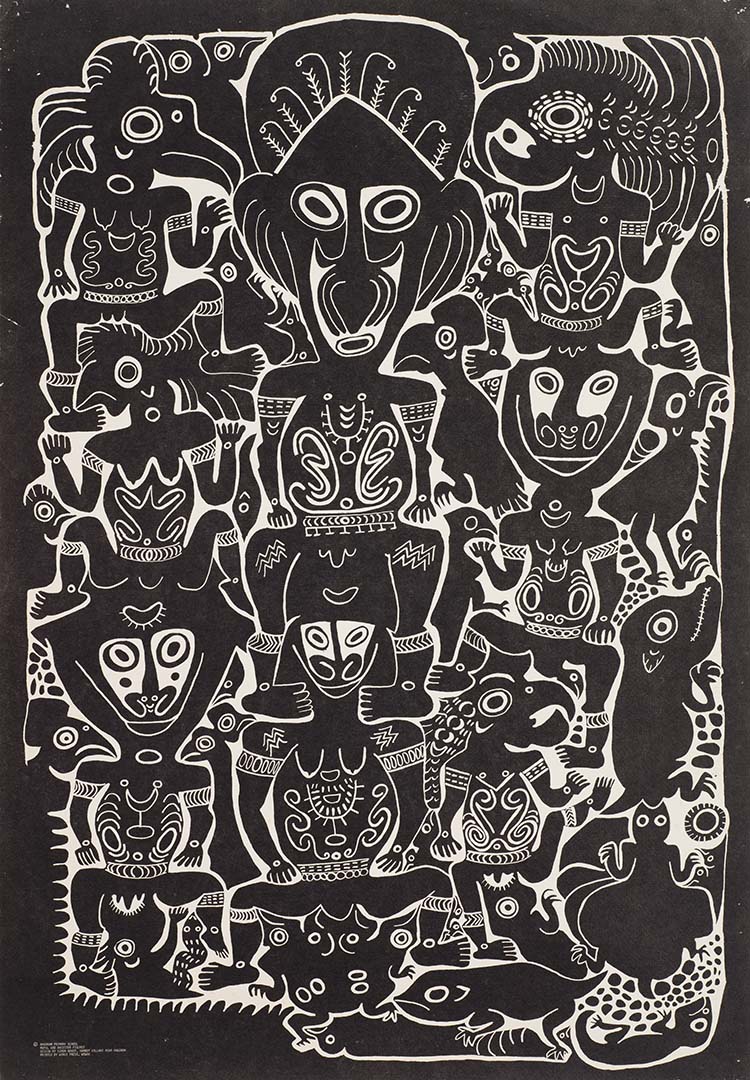We acknowledge the Traditional Owners of the land on which the Queensland Art Gallery | Gallery of Modern Art stands and recognise the creative contribution First Australians make to the art and culture of this country.

Simon Nowep / Artist / Kambot people, East Sepik Province / Papua New Guinea 1902–84 / Helen Dennett / Designer / Australia b.1940 / Wirui Press / Printer / Wewak, East Sepik Province / Papua New Guinea est. c.1960s / Wain and his followers c.1974 / Screen print on paper / 55.5 x 39cm / Gift of Helen and Paul Dennett through the Queensland Art Gallery | Gallery of Modern Art Foundation 2016 / Collection: Queensland Art Gallery | Gallery of Modern Art / © The artists
SIMON NOWEPWain and his followers c.1974
Not Currently on Display
As a baby, Simon Nowep (1902–84) was taken into the sacred chambers of the Haus Tambaran in his village of Kambot in Papua New Guinea; his artworks were subsequently deeply connected to the spiritual lessons he learnt as a child. Traditional beliefs across much of Papua New Guinea rest on an understanding of the interdependence of all things, however distinct they may appear. The human, animal, vegetable and spirit worlds inhabit a shared space.
In Nowep’s drawings and paintings, this interconnectedness is clear. Primary ancestor figures and brothers, Mopul and Wain, together with their families and followers, are often placed in close association with local animals and plants. They tell the creation stories of the Kambot people and also carry knowledge about the environment and its cycles, lessons about important symbiotic relationships, and the consequences should the proper balance not be maintained.
Simon Nowep was the last man fully initiated into the sacred knowledge, songs and images associated with the Haus Tambaran in the village of Kambot on the Keram River, East Sepik Province. As in many Sepik communities, rapid social change brought about by colonisation and the introduction of Christianity, as well as the two-year military occupation by the Japanese Imperial forces during World War Two, disrupted traditional cycles of village life in Kambot.
In many ways, Nowep straddled two worlds — as a young man he was made a catechist for the Catholic mission but was deeply disturbed at the removal of works from the Haus Tambaran, deemed dangerous by the missionaries and attractive to collectors. Despite the pressures of the Church, Nowep resolutely continued to paint and to pass on to a younger generation the knowledge and values instilled by his elders. His works can be found in major museum collections around the world and the front of the Papua New Guinea National Museum and Art Gallery building in Port Moresby has a large painting inspired by a Nowep painting.
Discussion Questions
1. Can you identify an individual piece within this complex visual puzzle?
2. Wain is the elder of two brothers whom the Kambot people call their primary ancestors. Part of the story of Wain and his brother Mopul tells of how the village of Kambot was settled. Have you heard stories about important people from your family? Are there stories of how you came to live where you do now?
3. Simon Nowep juggled his Catholic faith with the spiritual traditions he learnt as a child. How can this print teach us about the need to maintain the proper balance in life?
Classroom Activities
1. Draw three symbols or images that represent an important story about your family and community. Create a balanced black and white drawing or use the sketches as a design for a lino print. Alternatively, paint your drawing using bright and pastel colours on a black piece of paper, leaving spaces around your original drawing so that each painted area is outlined in black.
2. Research the Sepik River in Papua New Guinea and see if you can identify some changes that are happening now, impacting the life of people on the river. Try drawing a picture of a system out of balance because of change.
3. Create a single painting that incorporates cultural symbols in order to make a comment on your multicultural community. Limit the number of cultures represented to two or three as you may need to research the cultural symbols as part of your preparation.